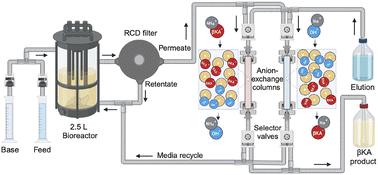Integration of metabolic and bioprocess engineering for the production of β-ketoadipic acid from glucose and xylose by Pseudomonas putida
IF 9.2
1区 化学
Q1 CHEMISTRY, MULTIDISCIPLINARY
引用次数: 0
Abstract
β-Ketoadipic acid is a common intermediate in aerobic microbial aromatic catabolism that can be used as a monomer in performance-advantaged biopolymers. Here, we engineered Pseudomonas putida KT2440 to produce β-ketoadipate from glucose and xylose, the most prevalent carbohydrates derived from lignocellulosic polysaccharides. With the top-performing strain, P. putida GR038, we conducted bioprocess development using glucose and xylose as substrates in a 2 : 1 molar ratio to mimic lignocellulosic hydrolysate. Fed-batch cultivations achieved a titer of 65.8 g L−1 and a rate of 0.69 g L−1 h−1, with a C-mol yield of 0.52. Application of adsorptive in situ product recovery further improved the effective titer to 92.0 g L−1 and the rate to 0.83 g L−1 h−1, while also improving the downstream purity of β-ketoadipate from 88.3 wt% to 99.0 wt%. These results show promise towards industrial production of β-ketoadipate from lignocellulosic sugars.

恶臭假单胞菌利用葡萄糖和木糖生产β-酮己二酸的代谢与生物工艺工程整合
β-酮己二酸是好氧微生物芳香分解代谢中常见的中间体,可以作为单体用于性能优越的生物聚合物。在这里,我们设计了恶臭假单胞菌KT2440,从葡萄糖和木糖中生产β-酮己二酸,木糖是木质纤维素多糖中最常见的碳水化合物。利用表现最好的菌株p.p putida GR038,我们以葡萄糖和木糖为底物,以2:1的摩尔比模拟木质纤维素水解,进行了生物工艺开发。分批补料培养的滴度为65.8 g L−1,速率为0.69 g L−1 h−1,C-mol产率为0.52。应用吸附原位产物回收进一步将有效滴度提高到92.0 g L−1,速率提高到0.83 g L−1 h−1,同时将β-酮己二酸的下游纯度从88.3% wt%提高到99.0% wt%。这些结果显示了从木质纤维素糖工业生产β-酮己二酸的前景。
本文章由计算机程序翻译,如有差异,请以英文原文为准。
求助全文
约1分钟内获得全文
求助全文
来源期刊

Green Chemistry
化学-化学综合
CiteScore
16.10
自引率
7.10%
发文量
677
审稿时长
1.4 months
期刊介绍:
Green Chemistry is a journal that provides a unique forum for the publication of innovative research on the development of alternative green and sustainable technologies. The scope of Green Chemistry is based on the definition proposed by Anastas and Warner (Green Chemistry: Theory and Practice, P T Anastas and J C Warner, Oxford University Press, Oxford, 1998), which defines green chemistry as the utilisation of a set of principles that reduces or eliminates the use or generation of hazardous substances in the design, manufacture and application of chemical products. Green Chemistry aims to reduce the environmental impact of the chemical enterprise by developing a technology base that is inherently non-toxic to living things and the environment. The journal welcomes submissions on all aspects of research relating to this endeavor and publishes original and significant cutting-edge research that is likely to be of wide general appeal. For a work to be published, it must present a significant advance in green chemistry, including a comparison with existing methods and a demonstration of advantages over those methods.
 求助内容:
求助内容: 应助结果提醒方式:
应助结果提醒方式:


